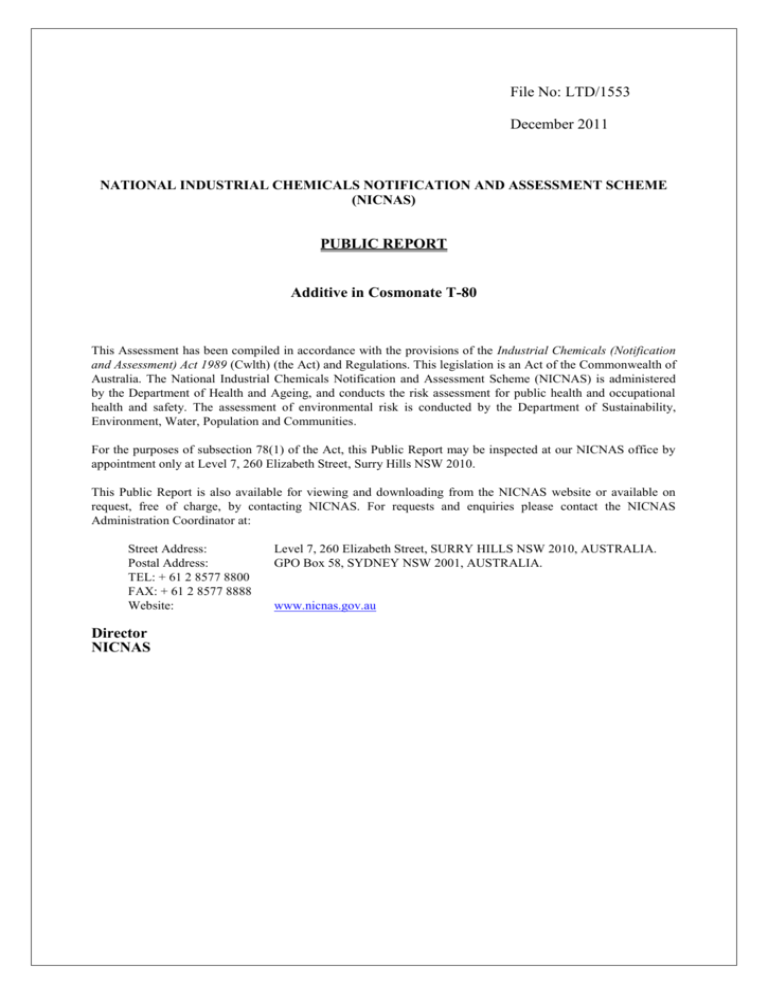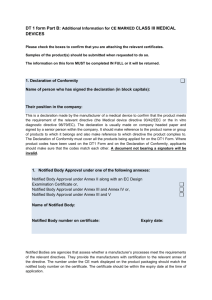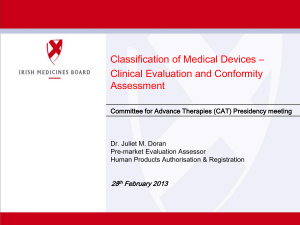LTD/1553
advertisement

File No: LTD/1553 December 2011 NATIONAL INDUSTRIAL CHEMICALS NOTIFICATION AND ASSESSMENT SCHEME (NICNAS) PUBLIC REPORT Additive in Cosmonate T-80 This Assessment has been compiled in accordance with the provisions of the Industrial Chemicals (Notification and Assessment) Act 1989 (Cwlth) (the Act) and Regulations. This legislation is an Act of the Commonwealth of Australia. The National Industrial Chemicals Notification and Assessment Scheme (NICNAS) is administered by the Department of Health and Ageing, and conducts the risk assessment for public health and occupational health and safety. The assessment of environmental risk is conducted by the Department of Sustainability, Environment, Water, Population and Communities. For the purposes of subsection 78(1) of the Act, this Public Report may be inspected at our NICNAS office by appointment only at Level 7, 260 Elizabeth Street, Surry Hills NSW 2010. This Public Report is also available for viewing and downloading from the NICNAS website or available on request, free of charge, by contacting NICNAS. For requests and enquiries please contact the NICNAS Administration Coordinator at: Street Address: Postal Address: TEL: + 61 2 8577 8800 FAX: + 61 2 8577 8888 Website: Director NICNAS Level 7, 260 Elizabeth Street, SURRY HILLS NSW 2010, AUSTRALIA. GPO Box 58, SYDNEY NSW 2001, AUSTRALIA. www.nicnas.gov.au TABLE OF CONTENTS SUMMARY ............................................................................................................................................................ 3 CONCLUSIONS AND REGULATORY OBLIGATIONS ................................................................................... 3 ASSESSMENT DETAILS ..................................................................................................................................... 4 1. APPLICANT AND NOTIFICATION DETAILS .................................................................................... 4 2. IDENTITY OF CHEMICAL .................................................................................................................... 4 3. COMPOSITION ....................................................................................................................................... 5 4. PHYSICAL AND CHEMICAL PROPERTIES ....................................................................................... 5 5. INTRODUCTION AND USE INFORMATION ..................................................................................... 5 6. HUMAN HEALTH IMPLICATIONS ..................................................................................................... 6 7. ENVIRONMENTAL IMPLICATIONS ................................................................................................... 7 APPENDIX A: ENVIRONMENTAL FATE AND ECOTOXICOLOGICAL INVESTIGATIONS ................................................. 9 BIBLIOGRAPHY ................................................................................................................................................. 10 December 2011 NICNAS SUMMARY The following details will be published in the NICNAS Chemical Gazette: ASSESSMENT CHEMICAL OR HAZARDOUS INTRODUCTION REFERENCE APPLICANT(S) TRADE NAME SUBSTANCE VOLUME LTD/1553 Additive in Cosmonate T-80 ND* ≤ 1 tonne per annum Mitsubishi Australia Ltd *ND = not determined USE A component of polyurethane foam CONCLUSIONS AND REGULATORY OBLIGATIONS Hazard classification Based on the available data the notified chemical is not able to be classified as hazardous according to the Approved Criteria for Classifying Hazardous Substances [NOHSC:1008(2004)]. Human health risk assessment Under the conditions of the occupational settings described, the notified chemical is not considered to pose an unreasonable risk to the health of workers. When used in the proposed manner, the notified chemical is not considered to pose an unreasonable risk to public health. Environmental risk assessment On the basis of the assessed use pattern, the notified chemical is not considered to pose an unreasonable risk to the environment. Recommendations CONTROL MEASURES Occupational Health and Safety A copy of the MSDS should be easily accessible to employees. If products and mixtures containing the notified chemical are classified as hazardous to health in accordance with the Approved Criteria for Classifying Hazardous Substances [NOHSC:1008(2004)] workplace practices and control procedures consistent with provisions of State and Territory hazardous substances legislation must be in operation. Disposal The notified chemical should be disposed of to landfill. Emergency procedures Spills or accidental release of the notified chemical should be handled by physical containment, collection and subsequent safe disposal. Regulatory Obligations Secondary Notification This risk assessment is based on the information available at the time of notification. The Director may call for the reassessment of the chemical under secondary notification provisions based on changes in certain circumstances. Under Section 64 of the Industrial Chemicals (Notification and Assessment) Act (1989) the notifier, as well as any other importer or manufacturer of the notified chemical, have post-assessment regulatory obligations to notify NICNAS when any of these circumstances change. These obligations apply even when the notified chemical is listed on the Australian Inventory of Chemical Substances (AICS). PUBLIC REPORT: LTD/1553 Page 3 of 10 December 2011 NICNAS Therefore, the Director of NICNAS must be notified in writing within 28 days by the notifier, other importer or manufacturer: (1) Under Section 64(1) of the Act; if the importation volume exceeds one tonne per annum notified chemical; or (2) Under Section 64(2) of the Act; if the function or use of the chemical has changed from a component of polyurethane foam, or is likely to change significantly; the amount of chemical being introduced has increased from 1 tonne per annum, or is likely to increase, significantly; the chemical has begun to be manufactured in Australia; additional information has become available to the person as to an adverse effect of the chemical on occupational health and safety, public health, or the environment. The Director will then decide whether a reassessment (i.e. a secondary notification and assessment) is required. Material Safety Data Sheet The MSDS of the notified chemical and products containing the notified chemical provided by the notifier were reviewed by NICNAS. The accuracy of the information on the MSDS remains the responsibility of the applicant. ASSESSMENT DETAILS 1. APPLICANT AND NOTIFICATION DETAILS APPLICANT(S) Mitsubishi Australia Ltd (ABN 81 004 354 278) Level 36, 120 Collins Street MELBOURNE, VIC 3000 NOTIFICATION CATEGORY Limited-small volume: Chemical other than polymer (1 tonne or less per year). EXEMPT INFORMATION (SECTION 75 OF THE ACT) Data items and details claimed exempt from publication: chemical name, other names, CAS number, molecular and structural formulae, molecular weight and analytical data. VARIATION OF DATA REQUIREMENTS (SECTION 24 OF THE ACT) Variation to the schedule of data requirements is claimed as follows: melting point, boiling point, density, vapour pressure, water solubility, partition coefficient, adsorption/desorption, hydrolysis as a function of pH, dissociation constant, flammability limits and autoignition temperature. PREVIOUS NOTIFICATION IN AUSTRALIA BY APPLICANT(S) None NOTIFICATION IN OTHER COUNTRIES None 2. IDENTITY OF CHEMICAL MARKETING NAME(S) Cosmonate T-80 MOLECULAR WEIGHT > 500 Da ANALYTICAL DATA Reference IR spectra were provided. PUBLIC REPORT: LTD/1553 Page 4 of 10 December 2011 3. NICNAS COMPOSITION DEGREE OF PURITY > 98% HAZARDOUS IMPURITIES/RESIDUAL MONOMERS None NON HAZARDOUS IMPURITIES/RESIDUAL MONOMERS (>1% by weight) ADDITIVES/ADJUVANTS 4. None None PHYSICAL AND CHEMICAL PROPERTIES APPEARANCE AT 20 ºC AND 101.3 kPa: Transparent and colourless liquid. Property Melting Point/Freezing Point Boiling Point Density Vapour Pressure Value Not determined 505.66 1,040 kg/m3 at 25 oC 3.25 × 10-11 kPa at 25 oC Water Solubility 0. 6 g/L at 20oC Hydrolysis as a Function of pH Not determined Partition Coefficient (n-octanol/water) Adsorption/Desorption log KOW = 7.0 at 20oC Dissociation Constant Not determined Flash Point Autoignition Temperature 212 oC Not determined Explosive Properties Not expected to be explosive Oxidising Properties Not oxidising log KOC= 6.1 at 20C Data Source/Justification Liquid at room temperature Calculated (EPIWIN) MSDS Calculated using the Modified Grain Method (EPIWIN) Calculated using WSKOW v1. 41 (US EPA, 2009). The notified chemical is expected to be insoluble based on its structural information. The notified chemical is expected to be insoluble in water. However, slow hydrolysis may occur in the environmental pH range of 4 – 9. Calculated using KOWWIN v1.67 (US EPA, 2009). Calculated based on log Kow using KOCWIN v2.0 (US EPA, 2009). The notified chemical does not contain any functional groups that are dissociable. MSDS Not expected to autoignite under normal conditions of use, based on flashpoint. The structural formula contains no explosophores. Estimated based on chemical structure DISCUSSION OF PROPERTIES For full details of tests on physical and chemical properties, refer to Appendix A. Reactivity Stable under normal conditions of use. Dangerous Goods classification Based on the submitted physical-chemical data in the above table the notified chemical is not classified according to the Australian Dangerous Goods Code (NTC, 2007). However, the data above do not address all Dangerous Goods endpoints. Therefore, consideration of all endpoints should be undertaken before a final decision on the Dangerous Goods classification is made by the introducer of the chemical. 5. INTRODUCTION AND USE INFORMATION MODE OF INTRODUCTION OF NOTIFIED CHEMICAL (100%) OVER NEXT 5 YEARS The notified chemical will not be manufactured within Australia. The notified chemical will be imported as an additive at a concentration of < 1% in a toluene diisocyanate (TDI, CAS number 26471-62-5) product (Cosmonate T-80). PUBLIC REPORT: LTD/1553 Page 5 of 10 December 2011 NICNAS MAXIMUM INTRODUCTION VOLUME OF NOTIFIED CHEMICAL (100%) OVER NEXT 5 YEARS Year Tonnes 1 <1 2 <1 3 <1 4 <1 5 <1 PORT OF ENTRY Melbourne and Sydney TRANSPORTATION AND PACKAGING The product Cosmonate T-80 containing the notified chemical at a concentration of < 1% will be imported in 205 L metal drums. It will be transported from the dock to the notifier’s warehouse facility by road and then distributed to foam manufacturers also by road. USE The notified chemical will be used as an additive in TDI product (Cosmonate T-80) at a concentration of < 1%. The TDI will be used in the manufacture of polyurethane foam, as flexible slabstock or moulded components principally for the bedding, furniture or automotive market (seats, instrument panels or headrests). OPERATION DESCRIPTION The notified chemical will not be manufactured or reformulated within Australia. The TDI product containing the notified chemical at a concentration of < 1% will be imported in 205 L metal drums. At foam manufacturing sites, the 205 L drums will be connected to the holding tanks using a flexible transfer hose and pumping equipment will be used to decant the TDI product into the holding tanks. The holding tanks are connected to the foam manufacturing plant via fixed transfer pipes. The TDI product will be fed to a mixing head together with a polyol blend and other additives, further reducing the concentration of the notified chemical in the final foam. The reaction produces polyurethane foam which rapidly cures into either a slab or is injection-moulded into a particular shape. The foam manufacturing plant is fully automated, sealed and supplied with local fume extraction. 6. HUMAN HEALTH IMPLICATIONS 6.1. 6.1.1. Exposure Assessment Occupational Exposure CATEGORY OF WORKERS Category of Worker Transport and storage Foam manufacturing workers Maintenance workers Exposure Duration (hours/day) 2 8 2 Exposure Frequency (days/year) ≤ 20 ≤ 200 ≤ 20 EXPOSURE DETAILS It is anticipated that transport and storage workers would only be exposed to the notified chemical in the event of an accident. Dermal and ocular exposure to the product Cosmonate T-80 containing the notified chemical at a concentration of < 1% could occur during the connection of the transfer hoses to the imported drums. Exposure will be limited by the use of PPE including gloves, protective clothing and safety goggles. Inhalation exposure will be limited by the low calculated vapour pressure of the notified chemical and the expected use of respiratory protection by workers to protect against the presence of TDI, which is classified as Carc. Cat. 3; R40 T+; R26 Xi; R36/37/38 R42/43 R52-53, and will comprise the majority of the imported product Cosmonate T-80. Once the product containing the notified chemical has been transferred to the holding tanks, the foam manufacture is fully automated, sealed and supplied with local fume extraction and hence exposure to the notified chemical is expected to be low. In the event of a malfunction of the plant or during routine maintenance, the foam plant will be shut down and the lines will be flushed before maintenance workers commence work and thus, the exposure of these workers to the notified chemical is expected to be minimal. Once the foam has been cured the notified chemical will be entrapped within it and hence is not expected to be PUBLIC REPORT: LTD/1553 Page 6 of 10 December 2011 NICNAS bioavailable. 6.1.2. Public Exposure The notified chemical will not be made available to the public. The public will only come into contact with polyurethane foam articles containing the notified chemical at concentrations of < 1%, where the notified chemical will be entrapped within the foam and hence is not expected to be bioavailable. Therefore, the potential for exposure to the public during contact with articles containing polyurethane foam with notified chemical entrapped in it is expected to be low. 6.2. Human Health Effects Assessment No toxicity data were submitted. The notified chemical contains no functional groups that could indicate a potential human health hazard. Toxicokinetics, metabolism and distribution. Dermal absorption of the notified chemical is likely to be limited, based on the relatively high molecular weight (> 500 Da) and the expected hydrophobicity. Health hazard classification Based on the available data the notified chemical is not classified as hazardous according to the Approved Criteria for Classifying Hazardous Substances (NOHSC, 2004). 6.3. Human Health Risk Characterisation 6.3.1. Occupational Health and Safety There is no toxicological data available on the notified chemical, however, the chemical does not contain structural alerts for toxicity and the physico-chemical properties of the notified chemical indicate that dermal absorption is likely to be limited. Exposure to the notified chemical, at concentrations < 1%, by workers may occur during the connection of the transfer hoses to the imported drums. Exposure to the notified chemical will be limited by the controls in place to protect the workers against TDI which will comprise the majority of the imported product. Once the foam has been cured the notified chemical will be entrapped within it and hence it is not expected to be bioavailable. Therefore based on the expected low exposure the risk to workers is not considered to be unreasonable. 6.3.2. Public Health The notified chemical will only be available to the public as a component of polyurethane foam articles at concentrations of < 1% and will be entrapped within the foam and hence is not expected to be bioavailable. Based on the low expected exposure, the risk to the public is not considered to be unreasonable. 7. ENVIRONMENTAL IMPLICATIONS 7.1. Environmental Exposure & Fate Assessment 7.1.1. Environmental Exposure RELEASE OF CHEMICAL AT SITE The notified chemical will not be manufactured or reformulated within Australia. The notified chemical will be imported as an additive in a toluene diisocyanate (TDI) product for use in the manufacture of polyurethane foam, as flexible slabstock or moulded components principally for the bedding, furniture or automotive market (seats, instrument panels or headrests). No release of the chemical is expected from manufacture and reformulation processes. RELEASE OF CHEMICAL FROM USE Releases from the foam manufacturing facilities are anticipated to be limited given the use of closed-loop pipe-work. Wastes from residues in drums and spills are expected to be disposed of to landfill. Potentially contaminated wash water from spill clean-up, scrubbers and equipment cleaning will be discharged into an onsite wastewater treatment plant where the notified chemical will partition mainly to the sludge which will be disposed of to landfill. Any accidental leaks and spills are expected to be collected for disposal to landfill. RELEASE OF CHEMICAL FROM DISPOSAL PUBLIC REPORT: LTD/1553 Page 7 of 10 December 2011 NICNAS Most of the notified chemical will be incorporated into foam articles and moulded articles and are expected to be disposed of to landfill at the end of their useful lives. Any release during use is expected to be collected for disposal to landfill. Minor amounts of the notified chemical may be disposed of to sewer from contaminated washing water for spills or equipment at manufacturing facilities. However, the TDI product containing the notified chemical will react with moisture and crosslink into a solid mass. The notified chemical will be entrapped in the solid matrix, and exposure of the notified chemical to the aquatic environment is not likely. 7.1.2. Environmental Fate No environmental fate data were submitted. Most of the notified chemical will be incorporated into foam articles and moulded articles which are expected to be disposed of to landfill at the end of their useful lives. A small amount of the notified chemical will be sent to landfill as collected releases from foam manufacturing facilities. In landfill, the notified chemical will undergo slow degradation processes via biotic and abiotic pathways, eventually forming water and oxides of carbon and phosphorous. Since the TDI product containing the notified chemical will react with moisture and crosslink into a solid mass, entrapping the notified chemical within the solid matrix, the notified chemical is not considered to be bioavailable in the unlikely case of release to the aquatic environment. 7.1.3. Predicted Environmental Concentration (PEC) The PEC was not calculated since no significant release of the notified chemical to the aquatic environment is expected from the proposed use pattern. 7.2. Environmental Effects Assessment No ecotoxicity data were submitted. In addition, no effects at saturation are predicted for the notified chemical by ECOSAR v1.0 (US EPA, 2009). 7.2.1. Predicted No-Effect Concentration The PNEC was not calculated since no ecotoxicological effects on aquatic species are expected for the notified chemical. 7.3. Environmental Risk Assessment Most of the notified chemical will be incorporated into foam articles and moulded articles and is not expected to be bioavailable in this form. The articles containing the notified chemical are expected to be sent to landfill at the end of their useful lives. In landfill, the notified chemical will undergo slow degradation processes via biotic and abiotic pathways, eventually forming water and oxides of carbon. Based on the reported use pattern, the notified chemical is not considered to pose an unreasonable risk to the environment. PUBLIC REPORT: LTD/1553 Page 8 of 10 December 2011 NICNAS APPENDIX A: ENVIRONMENTAL FATE AND ECOTOXICOLOGICAL INVESTIGATIONS A.1. Environmental Fate A.1.1. Bioaccumulation TEST SUBSTANCE Notified chemical CONCLUSION Test not conducted. Given the molecular weight of < 1000 Da and high predicted log KOW for the notified chemical, it may have high potential for bioaccumulation. However, since TDI will react with moisture and crosslink into a solid mass, entrapping the notified chemical with the solid matrix, the notified chemical is not considered to be bioavailable to aquatic species. PUBLIC REPORT: LTD/1553 Page 9 of 10 December 2011 NICNAS BIBLIOGRAPHY NOHSC (1994) National Code of Practice for the Labelling of Workplace Substances [NOHSC:2012(1994)]. National Occupational Health and Safety Commission, Canberra, Australian Government Publishing Service. NOHSC (2003) National Code of Practice for the Preparation of Material Safety Data Sheets, 2 nd edition [NOHSC:2011(2003)]. National Occupational Health and Safety Commission, Canberra, Australian Government Publishing Service. NOHSC (2004) Approved Criteria for Classifying Hazardous Substances, 3 rd edition [NOHSC:1008(2004)]. National Occupational Health and Safety Commission, Canberra, AusInfo. NTC (National Transport Commission) 2007 Australian Code for the Transport of Dangerous Goods by Road and Rail (ADG code), 7th Edition, Commonwealth of Australia. United Nations (2009) Globally Harmonised System of Classification and Labelling of Chemicals (GHS), 3rd revised edition. United Nations Economic Commission for Europe (UN/ECE), <http://www.unece.org/trans/danger/publi/ghs/ghs_rev03/03files_e.html >. US EPA (2009) Estimation Programs Interface Suite™ for Microsoft® Windows, v 4.00. United States Environmental Protection Agency. Washington, DC, USA, <http://www.epa.gov/oppt/exposure/pubs/episuite.htm>. Accessed 2011, October 14. PUBLIC REPORT: LTD/1553 Page 10 of 10





